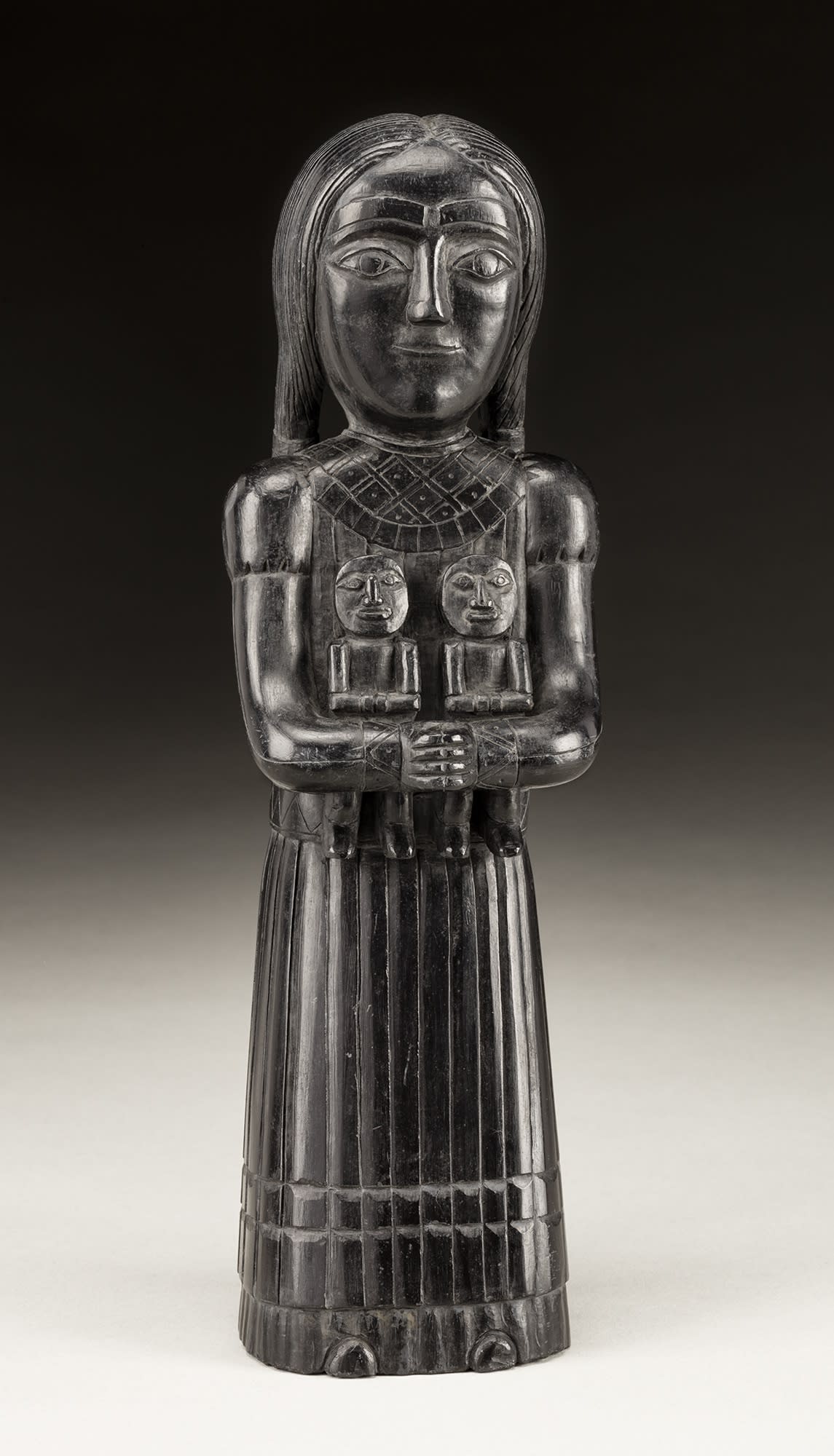Lot 51
UNIDENTIFIED ARTIST, HAIDA
Female Figure Holding Two Dolls, c. 1840-1860
argillite, 10.75 x 3.25 x 2.25 in (27.3 x 8.3 x 5.7 cm)
unsigned.
ESTIMATE: $18,000 — $28,000
PRICE REALIZED: $38,400
Provenance
Private Collection, British Columbia.
Standing figures of Euro-American men (commonly referred to as "Sea Captains" though not all of them were such) are among the most fascinating and charming works of nineteenth-century Haida argillite art. Carved mostly in the 1840s and 1850s many seem to be portraits, and no doubt some were commissioned. The figures' clothes, hair and other features were carved in remarkable, often individualistic detail. Typically, sea captain figures were dressed in naval uniforms or formal attire, usually wearing some form of cap. Their physiques are exaggeratedly slim, with long legs, small hands and narrow facial features; some had inset bone or ivory faces.
Standing figures of Euro-American women (or females in Euro-American dress) are less common, though interestingly they appear fairly frequently in the elaborate ship's pipes carved during the same period. While a few of these female subjects (including "captains' wives") would have represented foreigners, many likely would have been Indigenous women. Like the sea captain sculptures these figures are remarkable in aspect; their clothing displays carefully delineated folds, pleats, and decorative details, and their hair is often beautifully combed and plaited.
Female Figure Holding Two Dolls is absolutely one of the most strikingly beautiful works we have seen in this genre. Although the figure is definitely posed, she carries herself naturally and has none of the stiffness and slightly "priggish" look of some other examples. Her face is exceptionally beautiful, and her hair is simply but delicately styled into two ponytails. In our opinion the subject is a young Indigenous woman or quite possibly an adolescent. Her overall look of girlishness is reinforced by the fact that she appears to be holding a pair of dolls. Though doll-like, the figures may be dance puppets; however it has also been suggested that carved wooden figures - not just argillite works - were routinely made for sale to visitors by Haida artists, so perhaps this young woman is in fact offering them up for purchase [1]. The young lady's European-style clothing is simple but very elegant; the beautifully patterned neckline adds a finishing touch to the ceremonial, almost regal quality that this gorgeous sculpture radiates. Spectacular.
1. Thomas Vaughan and Bill Holm, Soft Gold (Oregon Historical Soc. Press, 1982/90), p. 161.
References: See the section on Euro-American figures in Peter L. Macnair and Alan L. Hoover, The Magic Leaves: A History of Haida Argillite Carving (Victoria: Royal BC Museum, 1984/2002), pp. 56-61. For a discussion and photos of similar figures (mostly male) see Leslie Drew and Douglas Wilson, Argillite: Art of the Haida (North Vancouver: Hancock House, 1980), pp. 189-192. For male Euro-American figures see Daina Augaitis et al, Raven Travelling: Two Centuries of Haida Art (Vancouver: Vancouver Art Gallery and Douglas & McIntyre, 2006) cats. 72-73 (Royal BC Museum and Peabody Museum); Thomas Vaughan and Bill Holm, Soft Gold (Portland, OR: Oregon Historical Society Press, 1982/90), cats. 111-114; and Aldona Jonaitis, Art of the Northwest Coast (Seattle/Vancouver: Univ. of Washington Press/D&M, 2006), p. 192. For a particularly impressive example of a captain see Walker's Auctions, May 2016, Lot 106 (now in UBC MOA Collection). For a striking argillite and bone Woman and Young Girl c. 1840-1860, see Walker's Auctions, Nov. 2014 Lot 160 (now also at UBC MOA). MOA and the Autry Museum have other lovely examples, viewable online through RRN. For illustrations of Tsimshian puppets see Allen Wardwell, Tangible Visions: Northwest Coast Indian Shamanism and its Art (New York: Mancelli Press, 1996), pp. 316-319. For a small Tlingit figure of a shaman see Donald Ellis Gallery, Donald Ellis Gallery 11, (Toronto: 2011), unpag.

